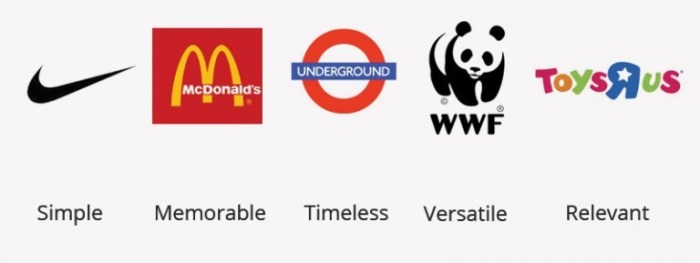Embark on a journey into the realm of logo design with How to Design a Logo: 10 Principles of Effective Logo Design. Uncover the secrets behind creating impactful logos that leave a lasting mark on viewers’ minds.
Explore the key elements and processes that go into designing a logo that not only captures attention but also communicates the essence of a brand effectively.
Principles of Effective Logo Design

When it comes to designing a logo, there are several key principles that designers need to keep in mind to ensure the effectiveness of the final product. These principles serve as guidelines to create a logo that is not only visually appealing but also memorable and timeless.
Importance of Simplicity
Simplicity is crucial in logo design because a simple logo is easier to recognize and remember. A cluttered or overly complex logo can be confusing to the audience and may not leave a lasting impression. Logos like Apple, Nike, and McDonald’s are perfect examples of how simplicity can make a logo iconic and easily recognizable.
Versatility in Design
A successful logo should be versatile and scalable to different sizes and mediums without losing its impact. Logos like the one for FedEx, which cleverly incorporates an arrow, demonstrate how a simple design element can add depth and versatility to a logo.
Memorability for Lasting Impression
Creating a memorable logo is essential for brand recognition and recall. Logos like Coca-Cola, with its distinctive cursive font, have become ingrained in popular culture due to their memorability. A memorable logo can leave a lasting impression on consumers and help build brand loyalty.
Timelessness for Longevity
A timeless logo design is one that remains relevant and effective regardless of changing trends. Logos like the one for Mercedes-Benz have stood the test of time due to their classic and elegant design. Investing in a timeless logo ensures that it will not become outdated quickly, saving the brand from frequent redesigns.
Key Elements of Logo Design

When it comes to designing a logo, there are several key elements that play a crucial role in creating a successful and impactful design. These elements include color choice, typography, and the use of negative space.
Color Choice in Evoking Emotions and Brand Identity
Color choice is one of the most important aspects of logo design as different colors evoke different emotions and perceptions. For example, red can symbolize passion and energy, while blue often conveys trust and reliability. It’s essential to select colors that align with the brand’s identity and the message it wants to convey. A well-chosen color palette can help a logo stand out and create a lasting impression on the audience.
Typography in Conveying the Right Message
Typography plays a significant role in conveying the right message through a logo. The choice of fonts can communicate the brand’s personality, whether it’s modern and sleek or traditional and elegant. The style, size, and spacing of the text all contribute to the overall impact of the logo. It’s essential to select typography that is legible, memorable, and aligns with the brand’s image.
Use of Negative Space for Hidden Meanings
Negative space, the empty space around and between the elements of a design, can be utilized cleverly to create hidden meanings or dual interpretations in a logo. By strategically incorporating negative space, designers can add depth and complexity to the design, making it more engaging and memorable. Some of the most iconic logos, such as the FedEx logo with an arrow hidden in the negative space between the “E” and “X,” showcase the power of utilizing negative space effectively.
Effective Balance of Different Elements
Effective logo designs strike a balance between different elements such as color, typography, imagery, and negative space. A successful logo seamlessly integrates these elements to create a cohesive and visually appealing design that represents the brand accurately. Logos like the Nike Swoosh, Apple’s iconic apple symbol, and the McDonald’s golden arches are examples of logos that effectively balance various design elements to create a strong brand identity.
Process of Logo Creation

In the process of creating a logo, there are several key steps that designers follow to ensure a successful outcome. From conducting research to adapting the final design for various applications, each stage plays a crucial role in developing a strong and effective logo.
Research and Planning
Before diving into the design process, it is essential to conduct thorough research to understand the client’s brand, target audience, and competition. This research phase helps designers gather valuable insights that will inform the direction of the logo design. By analyzing the brand’s values, mission, and vision, designers can create a logo that accurately represents the essence of the business.
Sketching and Brainstorming
Once the research is complete, designers move on to the sketching and brainstorming phase. This stage involves exploring different ideas, concepts, and visual elements that could be incorporated into the logo. By sketching out various designs by hand, designers can quickly iterate and refine their ideas before moving on to the digital design phase.
Feedback and Revisions
After presenting initial logo concepts to the client, designers gather feedback and make revisions based on the client’s input. This collaborative process allows for the refinement and improvement of the logo design to ensure it aligns with the client’s vision and goals. Incorporating feedback from stakeholders is crucial in creating a logo that resonates with the target audience and effectively communicates the brand message.
Adaptation for Different Applications
Finally, once the logo design is finalized, designers must consider how the logo will appear across various applications and sizes. Whether it’s on a business card, website, or billboard, the logo should be scalable and adaptable to different mediums without losing its impact. Designers must ensure that the logo remains recognizable and effective in all contexts to maintain brand consistency and cohesiveness.
Ending Remarks

In conclusion, mastering the 10 principles of effective logo design is the gateway to crafting logos that resonate with audiences and stand the test of time. Dive into the world of logo creation armed with knowledge and creativity to leave a lasting impression on your target market.